Drivers Vs. Pedestrians

In theory, a simple principle ensures that drivers and walkers can safely share America’s streets: Pedestrians have the right of way. Yet across the country, the reality of the road is proving far more complicated – and dangerous – for drivers and pedestrians alike. The year 2016 saw an 11 percent surge in traffic-related pedestrian deaths nationwide, the largest year-over-year spike ever recorded. Simultaneously, traffic-related fatalities increased by roughly 6 percent despite ever-advancing car safety technologies.
Safety advocates cite increased rates of walking as a primary mode of transportation and the persistent distraction of smartphones among explanations for these troubling trends.
In light of these risks, we sought to better understand the state of driver and pedestrian relationships on the road. We asked 500 drivers and 500 pedestrians about the hazards and conflicts they’ve experienced personally. From lewd gestures to life-threatening maneuvers, our respondents revealed just how maddening and menacing driver and pedestrian behavior can be.
Reckless and rude
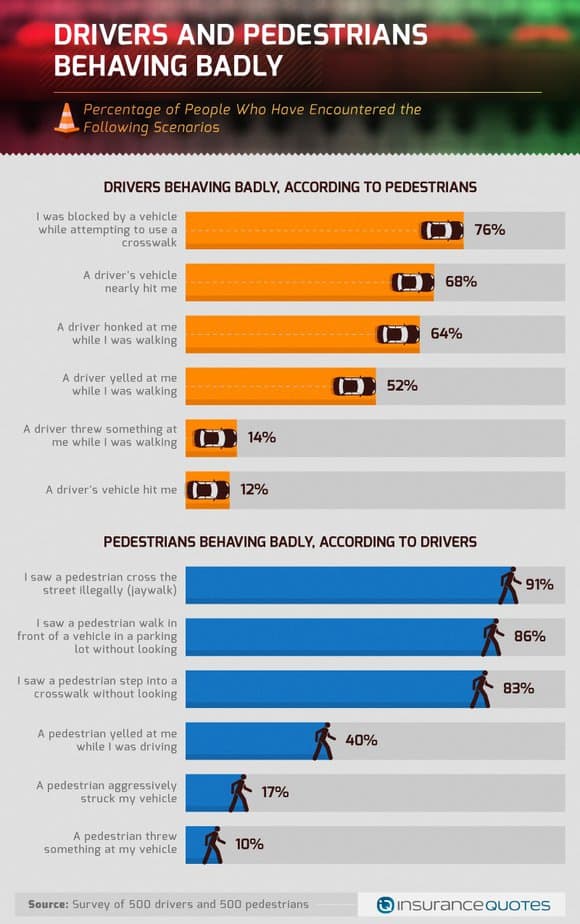
Pedestrian complaints about driver behavior ranged from small lapses in civility to more potentially serious incidents. The most common obnoxious behavior observed was a car blocking a crosswalk, though more than half of pedestrians of both genders said they’d been yelled and honked at as well. On the more threatening end of the spectrum, more than two-thirds of pedestrians said they’d nearly been hit by a car. Scarier still, 12 percent of walkers said they’d actually been hit by a vehicle before.
Drivers were even more likely to criticize pedestrian behaviors, such as stepping in their way without looking, both in parking lots and at crosswalks. Jaywalking was observed by 91 percent of drivers – supporting recent statistics showing 82 percent of pedestrian fatalities occur outside of intersections. Drivers reported aggressive behavior by pedestrians at high rates as well: 40 percent reported being yelled at by someone walking, while 17 percent said a pedestrian had struck their car.
Distraction nation
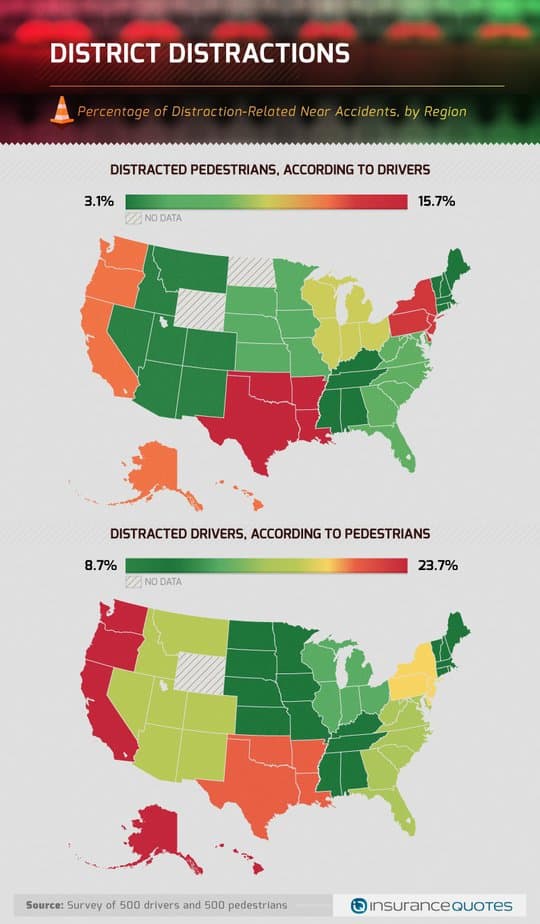
Turning to geographical differences in drivers’ and pedestrians’ actions, we saw distinct hotbeds of distraction on both sides of the street. In the Middle Atlantic, New York, Pennsylvania and New Jersey drivers reported strikingly high rates of near accidents due to their own attention issues.
Pennsylvania has struggled with distracted driving enforcement because newer laws include a loophole permitting mobile phone activity for any reason other than texting. New York and New Jersey, however, have banned all use of phones while behind the wheel, and their near accident rates remain quite high. Lest we assume this is strictly a Northern issue, states in the West South Central region reported high rates of close calls as well.
Interestingly, pedestrians most admitted to dangerous distractions on the West Coast, where 23.7 percent of walkers in the Pacific region said they’d stumbled into dangerous situations with some frequency. While Hawaii has already enacted legal restraints on “smartphone zombies” who walk into traffic unwittingly, local California lawmakers may now be following suit to address this problem on their own streets.
In the West South Central region, pedestrians reported their own distraction in high rates as well. This trend may be driven primarily by Texas, which is home to three of the nation’s most populous cities, allowing plenty of pedestrians ample opportunity to accidentally step into busy roadways.
States of anger
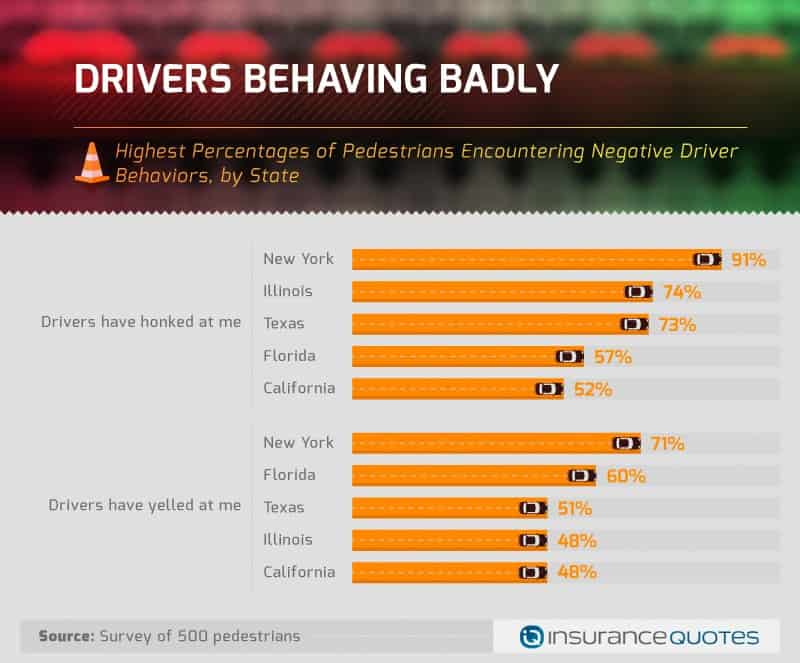
Going further, we explored the specific experiences of drivers and pedestrians in some of America’s most populous states. In each of the fives states above, the majority of pedestrians said they’d been honked at before – including 91 percent in New York and 74 percent in Illinois. In each state (aside from Florida), a lower percentage reported being yelled at by drivers. Sixty percent of pedestrians reported this unpleasant experience occurring in the Sunshine State.
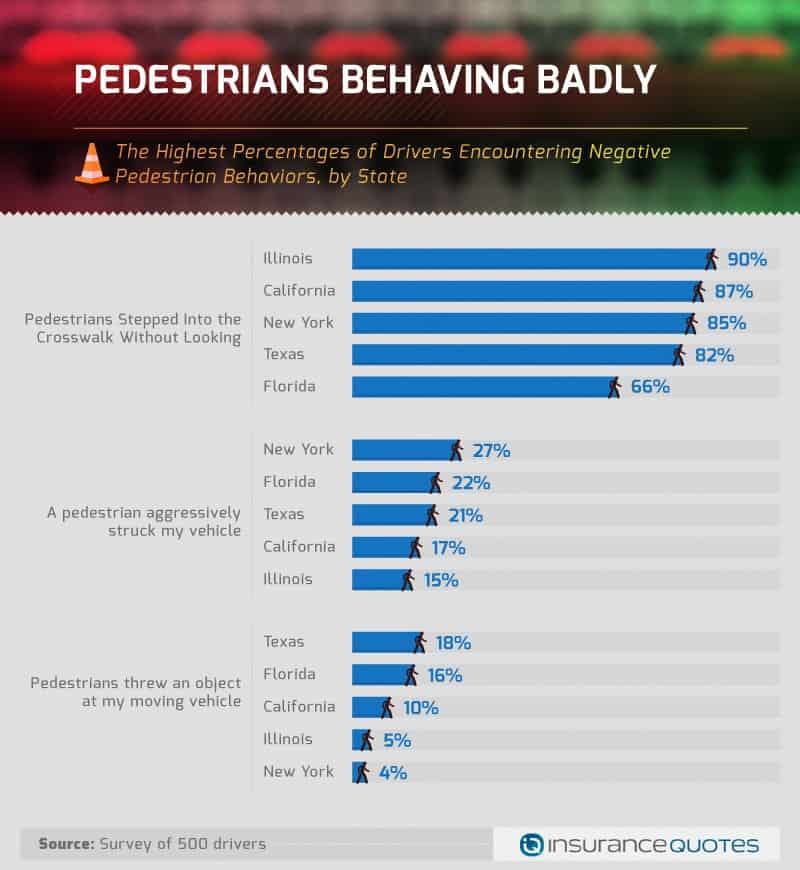
Drivers in these states had their own criticism of local walkers. They were particularly likely to report instances of pedestrians stepping in front of a car in a crosswalk without looking first. Ninety percent of Illinois drivers and 87 percent of California drivers recalled at least one instance of such an encounter. Meanwhile, New York drivers were most likely to report pedestrians striking their car in some way, and motorists in Texas said they’d had something hurled their way most often.
Automobile admissions
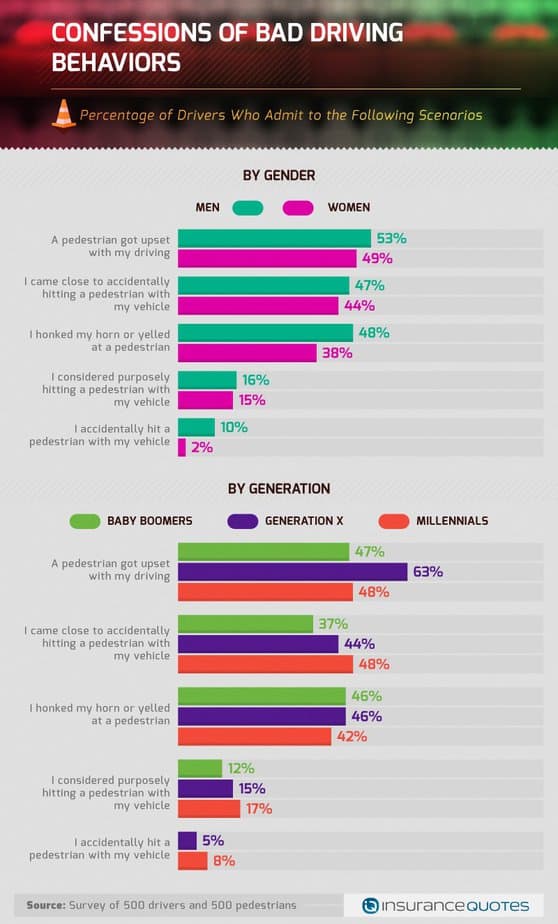
Whatever their complaints about others’ behavior, our respondents also admitted their own shortcomings related to road safety. Men were more likely than women to acknowledge each of these questionable driving incidents, though this gender difference was most pronounced in expressions of anger, such as horn honking or yelling at walkers.
While 47 percent of men and 44 percent of women admitted they’d come close to hitting a pedestrian, our findings revealed a wider disparity among drivers who had actually done so. Ten percent of male drivers admitted to hitting someone who was walking, while just 2 percent of women said the same.
Our generational comparisons produced more variation. Gen Xers, for instance, reported pedestrians getting angry at their driving far more often than any other age group. By contrast, millennials reported nearly (and actually) hitting a pedestrian most often. These findings suggest that some of the criticism of millennial driving habits may be justified – especially with regard to the dangerous use of their phones behind the wheel.
Then again, negligence may not solely be to blame: Millennials were also most likely to ponder hitting a pedestrian intentionally.
Partisan predicaments
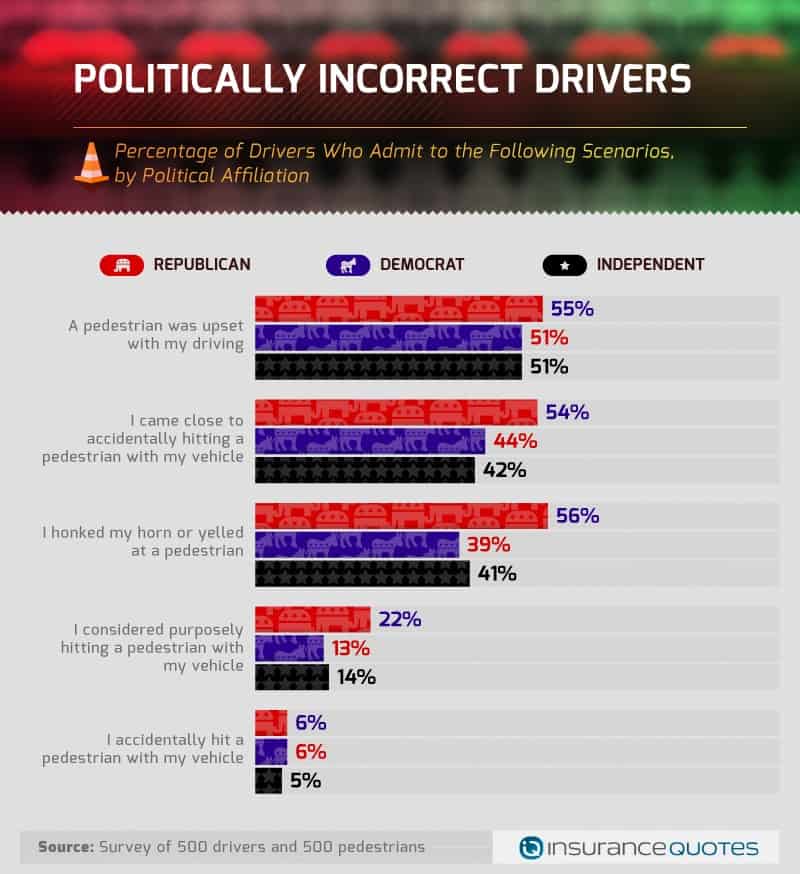
When we segmented our respondents’ dangerous driving experiences by political affiliation, a clear trend prevailed. Republican drivers were most likely to report every single experience, with the exception of actually hitting pedestrians, where they tied with Democrats at 6 percent. Conservatives were particularly likely to honk or yell at pedestrians relative to members of other parties, with a rate 15 percentage points higher than the next cohort, Independents.
These findings may relate in part to our earlier geographical conclusions. Drivers in the South Central region, a conservative stronghold, expressed intense frustration with pedestrian distraction. Accordingly, perhaps Republicans would attribute their close calls and angry responses to irresponsible pedestrians, rather than their own mistakes behind the wheel.
Safety of students
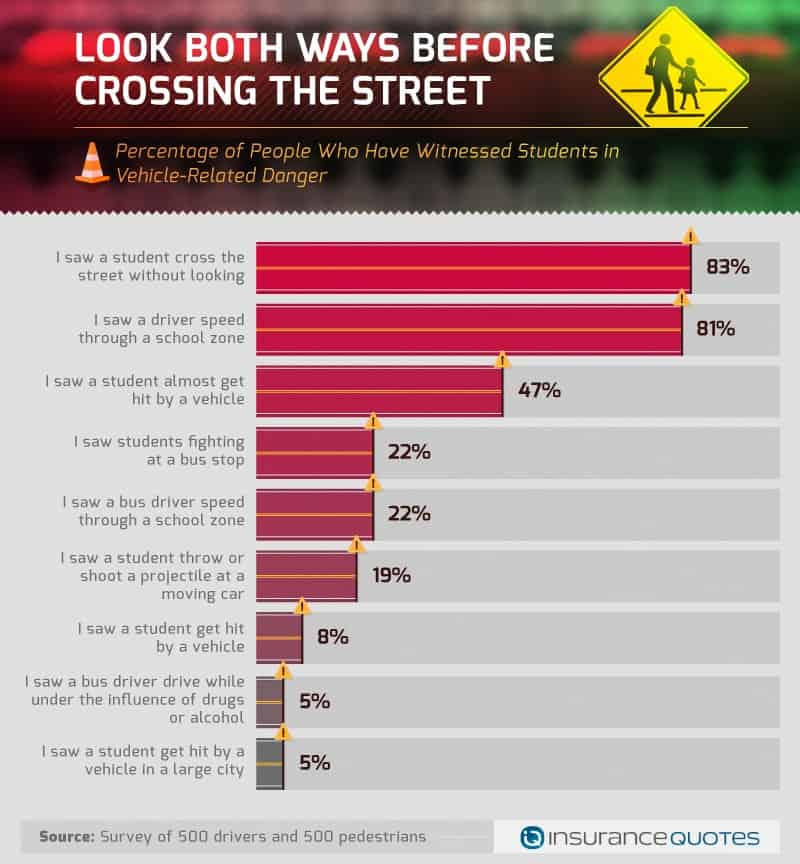
Finally, we analyzed our respondents’ observations of a particularly vulnerable pedestrian group: school-aged children. While the vast majority reported children crossing the street without looking first, 81 percent also said they’d seen a motorist speeding in a school zone. More troublingly still, 47 percent said they’d seen a student nearly get hit by a vehicle, while another 9 percent said they’d witnessed a child actually get hit.
These findings resonate with recent Centers for Disease Control and Prevention figures, which found that 1 in 5 children under age 15 who are killed in accidents are walking on the street.
Other respondents cited dangerous or rude behavior on the part of young students, however. More than 1 in 5 said they’d witnessed students fighting at a bus stop or even a bus driver speeding through a school zone. Students came under further fire, with 19 percent of respondents reporting seeing a pupil throw or shoot a projectile at a vehicle in motion.
Worse still, 5 percent of respondents said they’d seen a driver operate a school bus while under the influence, a terrifying prospect for children and parents (and anyone near the road) alike.
Safety sake
As our findings demonstrate, both pedestrians and drivers are prone to error and extreme emotion on America’s streets. Whether you get around on foot or always travel behind the wheel, we hope these results help you reconsider how often dangerous situations arise on the road. While no one intends to imperil themselves or others while going about their daily travel, life-threatening circumstances occur regularly as a result of negligence. By being more conscientious whenever we hit the road, we may spare those around us unnecessary anger – and even injury or death.
No matter how thoughtful we are about our own actions, accidents often arise because of circumstances beyond our control. That’s why the insuranceQuotes team strives to help America’s families secure the auto coverage they need at a price that won’t break the bank. Learn more about our resources and free rate quotes today.
Methodology
We surveyed 500 American drivers and 500 American pedestrians about their experiences driving and walking respectively. We asked them to describe the dangers and behaviors they had witnessed on the roadways, both as drivers and as pedestrians. For graphics in which respondents described close calls due to their own distraction, we included responses from those who said they’d “always,” “often,” or “sometimes” had such experiences Fifty percent of respondents identified as men, 47 percent of respondents identified as women, and 3 percent identified as a gender not listed by our survey.
